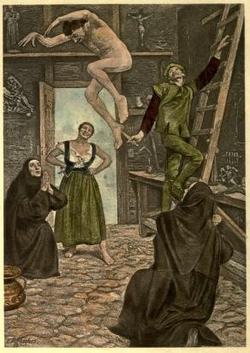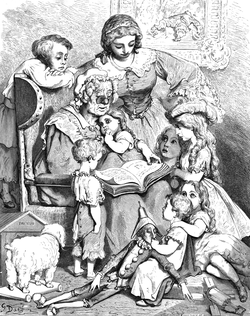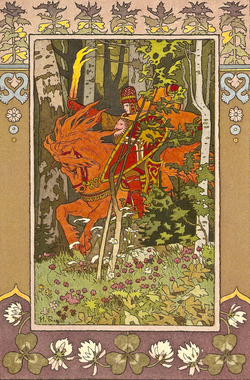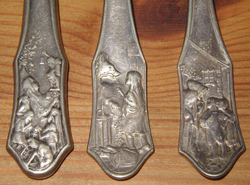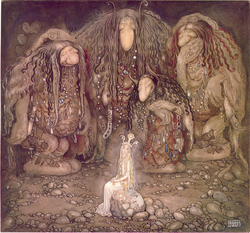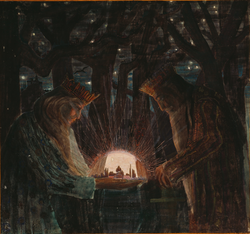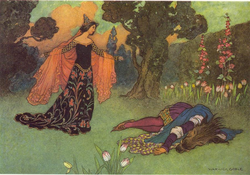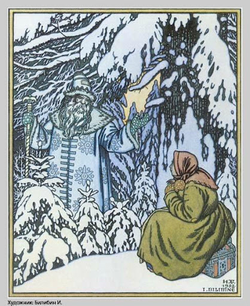Fairy tale
Fairy tale
A fairy tale is a type of short story that typically features folkloric fantasy characters, such as dwarfs, dragons, elves, fairies, giants, gnomes, goblins, griffins, mermaids, talking animals, trolls, unicorns, or witches, and usually magic or enchantments. Fairy tales may be distinguished from other folk narratives such as legends (which generally involve belief in the veracity of the events described) and explicitly moral tales, including beast fables. The term is mainly used for stories with origins in European tradition and, at least in recent centuries, mostly relates to children's literature.
In less technical contexts, the term is also used to describe something blessed with unusual happiness, as in "fairy tale ending" (a happy ending) or "fairy tale romance". Colloquially, a "fairy tale" or "fairy story" can also mean any far-fetched story or tall tale; it is used especially of any story that not only is not true, but could not possibly be true. Legends are perceived as real; fairy tales may merge into legends, where the narrative is perceived both by teller and hearers as being grounded in historical truth. However, unlike legends and epics, they usually do not contain more than superficial references to religion and actual places, people, and events; they take place once upon a time rather than in actual times.
Fairy tales are found in oral and in literary form; the name "fairy tale" was first ascribed to them by Madame d'Aulnoy in the late 17th century. Many of today's fairy tales have evolved from centuries-old stories that have appeared, with variations, in multiple cultures around the world. The history of the fairy tale is particularly difficult to trace because only the literary forms can survive. Still, according to researchers at universities in Durham and Lisbon, such stories may date back thousands of years, some to the Bronze Age more than 6,000 years ago. Fairy tales, and works derived from fairy tales, are still written today.
Folklorists have classified fairy tales in various ways.
The Aarne-Thompson classification system and the morphological analysis of Vladimir Propp are among the most notable. Other folklorists have interpreted the tales' significance, but no school has been definitively established for the meaning of the tales.
Terminology
Some folklorists prefer to use the German term Märchen or "wonder tale" to refer to the genre over fairy tale, a practice given weight by the definition of Thompson in his 1977 [1946] edition of The Folktale : "a tale of some length involving a succession of motifs or episodes. It moves in an unreal world without definite locality or definite creatures and is filled with the marvelous. In this never-never land, humble heroes kill adversaries, succeed to kingdoms and marry princesses." The characters and motifs of fairy tales are simple and archetypal: princesses and goose-girls; youngest sons and gallant princes; ogres, giants, dragons, and trolls; wicked stepmothers and false heroes; fairy godmothers and other magical helpers, often talking horses, or foxes, or birds; glass mountains; and prohibitions and breaking of prohibitions.
A fairy tale with a tragic rather than a happy end is called an anti-fairy tale.
Definition
Although the fairy tale is a distinct genre within the larger category of folktale, the definition that marks a work as a fairy tale is a source of considerable dispute.
The term itself comes from the translation of Madame D'Aulnoy's conte de fées, first used in her collection in 1697.) Common parlance conflates fairy tales with beast fables and other folktales, and scholars differ on the degree to which the presence of fairies and/or similarly mythical beings (e.g., elves, goblins, trolls, giants, huge monsters) should be taken as a differentiator. Vladimir Propp, in his Morphology of the Folktale, criticized the common distinction between "fairy tales" and "animal tales" on the grounds that many tales contained both fantastic elements and animals. Nevertheless, to select works for his analysis, Propp used all Russian folktales classified as a folk lore Aarne-Thompson 300-749 – in a cataloguing system that made such a distinction – to gain a clear set of tales. His own analysis identified fairy tales by their plot elements, but that in itself has been criticized, as the analysis does not lend itself easily to tales that do not involve a quest, and furthermore, the same plot elements are found in non-fairy tale works.
Were I asked, what is a fairytale?
I should reply, Read Undine : that is a fairytale... of all fairytales I know, I think Undine the most beautiful. — George MacDonald, The Fantastic Imagination
As Stith Thompson points out, talking animals and the presence of magic seem to be more common to the fairy tale than fairies themselves. However, the mere presence of animals that talk does not make a tale a fairy tale, especially when the animal is clearly a mask on a human face, as in fables.
In his essay "On Fairy-Stories", J. R. R. Tolkien agreed with the exclusion of "fairies" from the definition, defining fairy tales as stories about the adventures of men in Faërie , the land of fairies, fairytale princes and princesses, dwarves, elves, and not only other magical species but many other marvels. However, the same essay excludes tales that are often considered fairy tales, citing as an example The Monkey's Heart , which Andrew Lang included in The Lilac Fairy Book
Steven Swann Jones identified the presence of magic as the feature by which fairy tales can be distinguished from other sorts of folktales.
Davidson and Chaudri identify "transformation" as the key feature of the genre.
From a psychological point of view, Jean Chiriac argued for the necessity of the fantastic in these narratives.
In terms of aesthetic values, Italo Calvino cited the fairy tale as a prime example of "quickness" in literature, because of the economy and concision of the tales.
History of the genre
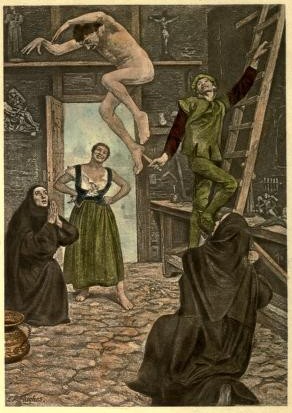
From The Facetious Nights of Straparola by Giovanni Francesco Straparola
Originally, stories that would contemporarily be considered fairy tales were not marked out as a separate genre.
The German term "Märchen" stems from the old German word "Mär", which means story or tale.
The word "Märchen" is the diminutive of the word "Mär", therefore it means a "little story". Together with the common beginning "once upon a time" it means a fairy tale or a märchen was originally a little story from a long time ago, when the world was still magic. (Indeed, one less regular German opening is "In the old times when wishing was still effective".)
The English term "fairy tale" stems from the fact that the French contes often included fairies.
Roots of the genre come from different oral stories passed down in European cultures.
The genre was first marked out by writers of the Renaissance, such as Giovanni Francesco Straparola and Giambattista Basile, and stabilized through the works of later collectors such as Charles Perrault and the Brothers Grimm. In this evolution, the name was coined when the précieuses took up writing literary stories; Madame d'Aulnoy invented the term conte de fée, or fairy tale, in the late 17th century.
Before the definition of the genre of fantasy, many works that would now be classified as fantasy were termed "fairy tales", including Tolkien's The Hobbit , George Orwell's Animal Farm , and L. Frank Baum's The Wonderful Wizard of Oz . Indeed, Tolkien's "On Fairy-Stories" includes discussions of world-building and is considered a vital part of fantasy criticism. Although fantasy, particularly the subgenre of fairytale fantasy, draws heavily on fairy tale motifs, the genres are now regarded as distinct.
Folk and literary
The fairy tale, told orally, is a sub-class of the folktale. Many writers have written in the form of the fairy tale. These are the literary fairy tales, or Kunstmärchen. The oldest forms, from Panchatantra to the Pentamerone , show considerable reworking from the oral form. The Brothers Grimm were among the first to try to preserve the features of oral tales. Yet the stories printed under the Grimm name have been considerably reworked to fit the written form.
Literary fairy tales and oral fairy tales freely exchanged plots, motifs, and elements with one another and with the tales of foreign lands.
The literary fairy tale came into fashion during the 17th century, developed by aristocratic women as a parlor game.
This in turn helped to maintain the oral tradition.
According to Jack Zipes, "The subject matter of the conversations consisted of literature, mores, taste, and etiquette, whereby the speakers all endeavored to portray ideal situations in the most effective oratorical style that would gradually have a major effect on literary forms." Many 18th-century folklorists attempted to recover the "pure" folktale, uncontaminated by literary versions. Yet while oral fairy tales likely existed for thousands of years before the literary forms, there is no pure folktale, and each literary fairy tale draws on folk traditions, if only in parody. This makes it impossible to trace forms of transmission of a fairy tale. Oral story-tellers have been known to read literary fairy tales to increase their own stock of stories and treatments.
History
The oral tradition of the fairy tale came long before the written page. Tales were told or enacted dramatically, rather than written down, and handed down from generation to generation. Because of this, the history of their development is necessarily obscure and blurred. Fairy tales appear, now and again, in written literature throughout literate cultures, as in The Golden Ass , which includes Cupid and Psyche (Roman, 100–200 AD), or the Panchatantra (India 3rd century BCE), but it is unknown to what extent these reflect the actual folk tales even of their own time. The stylistic evidence indicates that these, and many later collections, reworked folk tales into literary forms. What they do show is that the fairy tale has ancient roots, older than the Arabian Nights collection of magical tales (compiled circa 1500 AD), such as Vikram and the Vampire , and Bel and the Dragon . Besides such collections and individual tales, in China, Taoist philosophers such as Liezi and Zhuangzi recounted fairy tales in their philosophical works. In the broader definition of the genre, the first famous Western fairy tales are those of Aesop (6th century BC) in ancient Greece.
Jack Zipes writes in When Dreams Came True, "There are fairy tale elements in Chaucer's The Canterbury Tales , Edmund Spenser's The Faerie Queene , and... in many of William Shakespeare plays." King Lear can be considered a literary variant of fairy tales such as Water and Salt and Cap O' Rushes . The tale itself resurfaced in Western literature in the 16th and 17th centuries, with The Facetious Nights of Straparola by Giovanni Francesco Straparola (Italy, 1550 and 1553), which contains many fairy tales in its inset tales, and the Neapolitan tales of Giambattista Basile (Naples, 1634–6), which are all fairy tales. Carlo Gozzi made use of many fairy tale motifs among his Commedia dell'Arte scenarios, including among them one based on The Love For Three Oranges (1761). Simultaneously, Pu Songling, in China, included many fairy tales in his collection, Strange Stories from a Chinese Studio (published posthumously, 1766). The fairy tale itself became popular among the précieuses of upper-class France (1690–1710), and among the tales told in that time were the ones of La Fontaine and the Contes of Charles Perrault (1697), who fixed the forms of Sleeping Beauty and Cinderella
The Salon Era
In the mid-17th century, a vogue for magical tales emerged among the intellectuals who frequented the salons of Paris. These salons were regular gatherings hosted by prominent aristocratic women, where women and men could gather together to discuss the issues of the day.
In the 1630s, aristocratic women began to gather in their own living rooms, salons, in order to discuss the topics of their choice: arts and letters, politics, and social matters of immediate concern to the women of their class: marriage, love, financial and physical independence, and access to education.
This was a time when women were barred from receiving a formal education.
Some of the most gifted women writers of the period came out of these early salons (such as Madeleine de Scudéry and Madame de Lafayette), which encouraged women's independence and pushed against the gender barriers that defined their lives. The salonnières argued particularly for love and intellectual compatibility between the sexes, opposing the system of arranged marriages.
Sometime in the middle of the 17th century, a passion for the conversational parlour game based on the plots of old folk tales swept through the salons. Each salonnière was called upon to retell an old tale or rework an old theme, spinning clever new stories that not only showcased verbal agility and imagination, but also slyly commented on the conditions of aristocratic life. Great emphasis was placed on a mode of delivery that seemed natural and spontaneous. The decorative language of the fairy tales served an important function: disguising the rebellious subtext of the stories and sliding them past the court censors. Critiques of court life (and even of the king) were embedded in extravagant tales and in dark, sharply dystopian ones. Not surprisingly, the tales by women often featured young (but clever) aristocratic girls whose lives were controlled by the arbitrary whims of fathers, kings, and elderly wicked fairies, as well as tales in which groups of wise fairies (i.e., intelligent, independent women) stepped in and put all to rights.
The salon tales as they were originally written and published have been preserved in a monumental work called Le Cabinet des Fées, an enormous collection of stories from the 17th and 18th centuries.
Later works
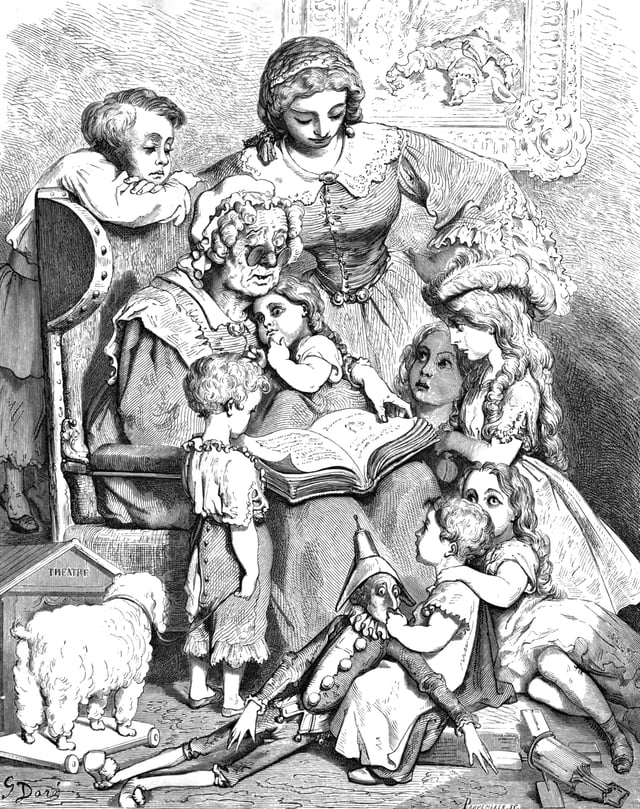
A picture by Gustave Doré of Mother Goose reading written (literary) fairy tales
The first collectors to attempt to preserve not only the plot and characters of the tale, but also the style in which they were told, were the Brothers Grimm, collecting German fairy tales; ironically, this meant although their first edition (1812 & 1815) remains a treasure for folklorists, they rewrote the tales in later editions to make them more acceptable, which ensured their sales and the later popularity of their work.
Such literary forms did not merely draw from the folktale, but also influenced folktales in turn.
The Brothers Grimm rejected several tales for their collection, though told orally to them by Germans, because the tales derived from Perrault, and they concluded they were thereby French and not German tales; an oral version of Bluebeard was thus rejected, and the tale of Little Briar Rose, clearly related to Perrault's The Sleeping Beauty , was included only because Jacob Grimm convinced his brother that the figure of Brynhildr, from much earlier Norse mythology, proved that the sleeping princess was authentically Germanic folklore.
This consideration of whether to keep Sleeping Beauty reflected a belief common among folklorists of the 19th century: that the folk tradition preserved fairy tales in forms from pre-history except when "contaminated" by such literary forms, leading people to tell inauthentic tales. The rural, illiterate, and uneducated peasants, if suitably isolated, were the folk and would tell pure folk tales. Sometimes they regarded fairy tales as a form of fossil, the remnants of a once-perfect tale. However, further research has concluded that fairy tales never had a fixed form, and regardless of literary influence, the tellers constantly altered them for their own purposes.
The work of the Brothers Grimm influenced other collectors, both inspiring them to collect tales and leading them to similarly believe, in a spirit of romantic nationalism, that the fairy tales of a country were particularly representative of it, to the neglect of cross-cultural influence. Among those influenced were the Russian Alexander Afanasyev (first published in 1866), the Norwegians Peter Christen Asbjørnsen and Jørgen Moe (first published in 1845), the Romanian Petre Ispirescu (first published in 1874), the English Joseph Jacobs (first published in 1890), and Jeremiah Curtin, an American who collected Irish tales (first published in 1890). Ethnographers collected fairy tales throughout the world, finding similar tales in Africa, the Americas, and Australia; Andrew Lang was able to draw on not only the written tales of Europe and Asia, but those collected by ethnographers, to fill his "coloured" fairy books series. They also encouraged other collectors of fairy tales, as when Yei Theodora Ozaki created a collection, Japanese Fairy Tales (1908), after encouragement from Lang. Simultaneously, writers such as Hans Christian Andersen and George MacDonald continued the tradition of literary fairy tales. Andersen's work sometimes drew on old folktales, but more often deployed fairytale motifs and plots in new tales. MacDonald incorporated fairytale motifs both in new literary fairy tales, such as The Light Princess , and in works of the genre that would become fantasy, as in The Princess and the Goblin or Lilith .
Cross-cultural transmission
Two theories of origins have attempted to explain the common elements in fairy tales found spread over continents.
One is that a single point of origin generated any given tale, which then spread over the centuries; the other is that such fairy tales stem from common human experience and therefore can appear separately in many different origins.
Fairy tales with very similar plots, characters, and motifs are found spread across many different cultures.
Many researchers hold this to be caused by the spread of such tales, as people repeat tales they have heard in foreign lands, although the oral nature makes it impossible to trace the route except by inference.
Folklorists have attempted to determine the origin by internal evidence, which can not always be clear; Joseph Jacobs, comparing the Scottish tale The Ridere of Riddles with the version collected by the Brothers Grimm, The Riddle , noted that in The Ridere of Riddles one hero ends up polygamously married, which might point to an ancient custom, but in The Riddle, the simpler riddle might argue greater antiquity.
Folklorists of the "Finnish" (or historical-geographical) school attempted to place fairy tales to their origin, with inconclusive results.
Sometimes influence, especially within a limited area and time, is clearer, as when considering the influence of Perrault's tales on those collected by the Brothers Grimm.
Little Briar-Rose appears to stem from Perrault's Sleeping Beauty, as the Grimms' tale appears to be the only independent German variant. Similarly, the close agreement between the opening of the Grimms' version of Little Red Riding Hood and Perrault's tale points to an influence, although the Grimms' version adds a different ending (perhaps derived from The Wolf and the Seven Young Kids ).
Fairy tales tend to take on the color of their location, through the choice of motifs, the style in which they are told, and the depiction of character and local color.
The Brothers Grimm believed that European fairy tales derived from the cultural history shared by all Indo-European peoples and were therefore ancient, far older than written records. This view is supported by research by the anthropologist Jamie Tehrani and the folklorist Sara Graca Da Silva using phylogenetic analysis, a technique developed by evolutionary biologists to trace the relatedness of living and fossil species. Among the tales analysed were Jack and the Beanstalk , traced to the time of splitting of Eastern and Western Indo-European, over 5000 years ago. Both Beauty and the Beast and Rumpelstiltskin appear to have been created some 4000 years ago. The story of The Smith and the Devil (Deal with the Devil) appears to date from the Bronze Age, some 6000 years ago.
Association with children
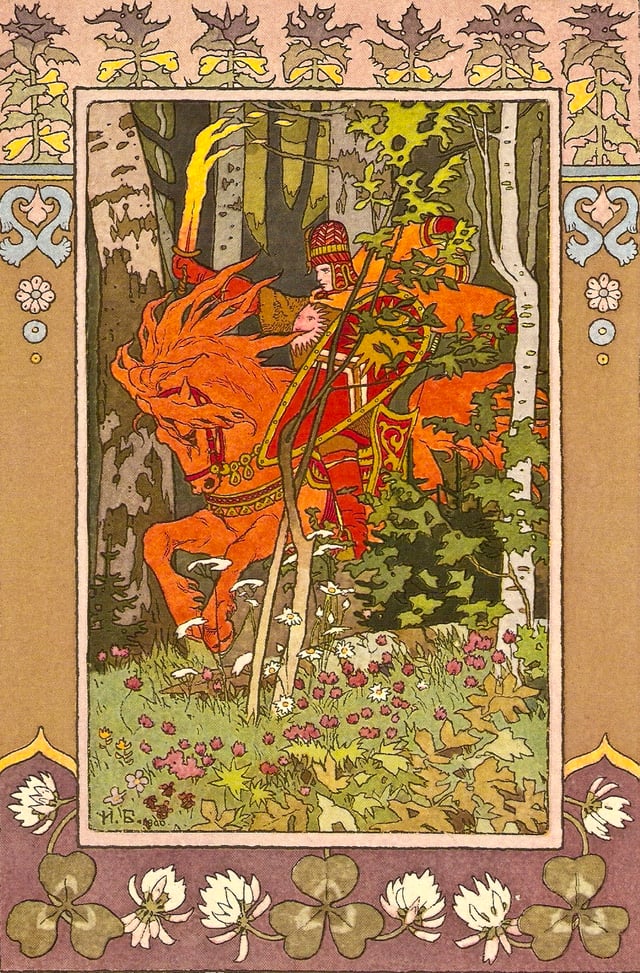
Ivan Bilibin's illustration of the Russian fairy tale about Vasilisa the Beautiful
Originally, adults were the audience of a fairy tale just as often as children.
Literary fairy tales appeared in works intended for adults, but in the 19th and 20th centuries the fairy tale became associated with children's literature.
The précieuses , including Madame d'Aulnoy, intended their works for adults, but regarded their source as the tales that servants, or other women of lower class, would tell to children. Indeed, a novel of that time, depicting a countess's suitor offering to tell such a tale, has the countess exclaim that she loves fairy tales as if she were still a child. Among the late précieuses, Jeanne-Marie Le Prince de Beaumont redacted a version of Beauty and the Beast for children, and it is her tale that is best known today. The Brothers Grimm titled their collection Children's and Household Tales
In the modern era, fairy tales were altered so that they could be read to children.
The Brothers Grimm concentrated mostly on sexual references; Rapunzel, in the first edition, revealed the prince's visits by asking why her clothing had grown tight, thus letting the witch deduce that she was pregnant, but in subsequent editions carelessly revealed that it was easier to pull up the prince than the witch. On the other hand, in many respects, violence—particularly when punishing villains—was increased. Other, later, revisions cut out violence; J. R. R. Tolkien noted that The Juniper Tree often had its cannibalistic stew cut out in a version intended for children. The moralizing strain in the Victorian era altered the classical tales to teach lessons, as when George Cruikshank rewrote Cinderella in 1854 to contain temperance themes. His acquaintance Charles Dickens protested, "In an utilitarian age, of all other times, it is a matter of grave importance that fairy tales should be respected."
Psychoanalysts such as Bruno Bettelheim, who regarded the cruelty of older fairy tales as indicative of psychological conflicts, strongly criticized this expurgation, because it weakened their usefulness to both children and adults as ways of symbolically resolving issues. Jungian Analyst and fairy tale scholar, Marie Louise Von Franz interprets fairy tales based on Jung‘s view of fairy tales as a spontaneous and naive product of soul, which can only express what soul is. That means, she looks at fairy tales as images of different phases of experiencing the reality of the soul. They are the “purest and simplest expression of collective unconscious psychic processes” and “they represent the archetypes in their simplest, barest and most concise form” because they are less overlaid with conscious material than myths and legends. “In this pure form, the archetypal images afford us the best clues to the understanding of the processes going on in the collective psyche”. “The fairy tale itself is its own best explanation; that is, its meaning is contained in the totality of its motifs connected by the thread of the story. [...] Every fairy tale is a relatively closed system compounding one essential psychological meaning which is expressed in a series of symbolical pictures and events and is discoverable in these”. “I have come to the conclusion that all fairy tales endeavour to describe one and the same psychic fact, but a fact so complex and far-reaching and so difficult for us to realize in all its different aspects that hundreds of tales and thousands of repetitions with a musician’s variation are needed until this unknown fact is delivered into consciousness; and even then the theme is not exhausted. This unknown fact is what Jung calls the Self, which is the psychic reality of the collective unconscious. [...] Every archetype is in its essence only one aspect of the collective unconscious as well as always representing also the whole collective unconscious.
The adaptation of fairy tales for children continues.
Walt Disney's influential Snow White and the Seven Dwarfs was largely (although certainly not solely) intended for the children's market. The anime Magical Princess Minky Momo draws on the fairy tale Momotarō . Jack Zipes has spent many years working to make the older traditional stories accessible to modern readers and their children.
Contemporary tales
Literary
In contemporary literature, many authors have used the form of fairy tales for various reasons, such as examining the human condition from the simple framework a fairytale provides. Some authors seek to recreate a sense of the fantastic in a contemporary discourse. Some writers use fairy tale forms for modern issues; this can include using the psychological dramas implicit in the story, as when Robin McKinley retold Donkeyskin as the novel Deerskin , with emphasis on the abusive treatment the father of the tale dealt to his daughter. Sometimes, especially in children's literature, fairy tales are retold with a twist simply for comic effect, such as The Stinky Cheese Man by Jon Scieszka and The ASBO Fairy Tales by Chris Pilbeam. A common comic motif is a world where all the fairy tales take place, and the characters are aware of their role in the story, such as in the film series Shrek.
Other authors may have specific motives, such as multicultural or feminist reevaluations of predominantly Eurocentric masculine-dominated fairy tales, implying critique of older narratives. The figure of the damsel in distress has been particularly attacked by many feminist critics. Examples of narrative reversal rejecting this figure include The Paperbag Princess by Robert Munsch, a picture book aimed at children in which a princess rescues a prince, and Angela Carter's The Bloody Chamber, which retells a number of fairy tales from a female point of view.
There are also many contemporary erotic retellings of fairy tales, which explicitly draw upon the original spirit of the tales, and are specifically for adults.
Modern retellings focus on exploring the tale through use of the erotic, explicit sexuality, dark and/or comic themes, female empowerment, fetish and BDSM, multicultural, heterosexual and LGBT characters. Cleis Press has released several fairy tale themed erotic anthologies, including Fairy Tale Lust, Lustfully Ever After, and A Princess Bound.
It may be hard to lay down the rule between fairy tales and fantasies that use fairy tale motifs, or even whole plots, but the distinction is commonly made, even within the works of a single author: George MacDonald's Lilith and Phantastes are regarded as fantasies, while his "The Light Princess", "The Golden Key", and "The Wise Woman" are commonly called fairy tales. The most notable distinction is that fairytale fantasies, like other fantasies, make use of novelistic writing conventions of prose, characterization, or setting.
Film
Fairy tales have been enacted dramatically; records exist of this in commedia dell'arte, and later in pantomime. The advent of cinema has meant that such stories could be presented in a more plausible manner, with the use of special effects and animation. The Walt Disney Company has had a significant impact on the evolution of the fairy tale film. Some of the earliest short silent films from the Disney studio were based on fairy tales, and some fairy tales were adapted into shorts in the musical comedy series "Silly Symphonies", such as Three Little Pigs . Walt Disney's first feature-length film Snow White and the Seven Dwarfs , released in 1937, was a ground-breaking film for fairy tales and, indeed, fantasy in general. Disney and his creative successors have returned to traditional and literary fairy tales numerous times with films such as Cinderella (1950), Sleeping Beauty (1959) and Beauty and the Beast (1991). Disney's influence helped establish the fairy tale genre as a genre for children, and has been accused by some of bowdlerizing the gritty naturalism – and sometimes unhappy endings – of many folk fairy tales. However, others note that the softening of fairy tales occurred long before Disney, some of which was even done by the Grimm brothers themselves.
Many filmed fairy tales have been made primarily for children, from Disney's later works to Aleksandr Rou's retelling of Vasilissa the Beautiful , the first Soviet film to use Russian folk tales in a big-budget feature. Others have used the conventions of fairy tales to create new stories with sentiments more relevant to contemporary life, as in Labyrinth , My Neighbor Totoro , Happily N'Ever After , and the films of Michel Ocelot.
Other works have retold familiar fairy tales in a darker, more horrific or psychological variant aimed primarily at adults.
Notable examples are Jean Cocteau's Beauty and the Beast and The Company of Wolves , based on Angela Carter's retelling of Little Red Riding Hood . Likewise, Princess Mononoke , Pan's Labyrinth , Suspiria , and Spike create new stories in this genre from fairy tale and folklore motifs.
In comics and animated TV series, The Sandman , Revolutionary Girl Utena , Princess Tutu , Fables and MÄR all make use of standard fairy tale elements to various extents but are more accurately categorised as fairytale fantasy due to the definite locations and characters which a longer narrative requires.
A more modern cinematic fairy tale would be Luchino Visconti's Le Notti Bianche , starring Marcello Mastroianni before he became a superstar. It involves many of the romantic conventions of fairy tales, yet it takes place in post-World War II Italy, and it ends realistically.
Motifs
_(14751020284).jpg)
The violet fairy book (1906)
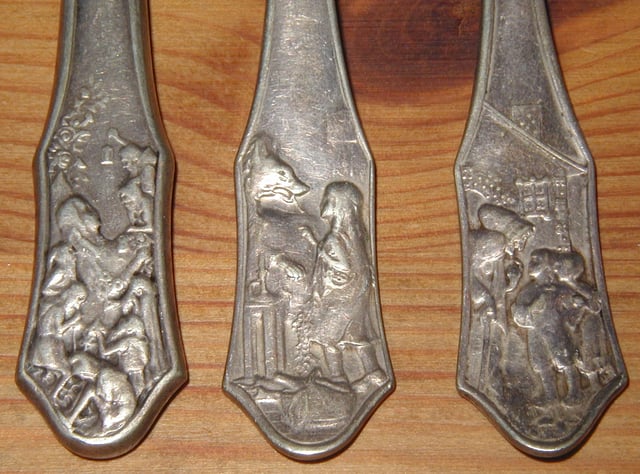
Cutlery for children.
Any comparison of fairy tales quickly discovers that many fairy tales have features in common with each other.
Two of the most influential classifications are those of Antti Aarne, as revised by Stith Thompson into the Aarne-Thompson classification system, and Vladimir Propp's Morphology of the Folk Tale
Aarne-Thompson
This system groups fairy and folk tales according to their overall plot.
Common, identifying features are picked out to decide which tales are grouped together.
Much therefore depends on what features are regarded as decisive.
For instance, tales like Cinderella – in which a persecuted heroine, with the help of the fairy godmother or similar magical helper, attends an event (or three) in which she wins the love of a prince and is identified as his true bride—are classified as type 510, the persecuted heroine. Some such tales are The Wonderful Birch ; Aschenputtel ; Katie Woodencloak ; The Story of Tam and Cam ; Ye Xian ; Cap O' Rushes ; Catskin ; Fair, Brown and Trembling ; Finette Cendron ; Allerleirauh
Further analysis of the tales shows that in Cinderella, The Wonderful Birch, The Story of Tam and Cam, Ye Xian, and Aschenputtel, the heroine is persecuted by her stepmother and refused permission to go to the ball or other event, and in Fair, Brown and Trembling and Finette Cendron by her sisters and other female figures, and these are grouped as 510A; while in Cap O' Rushes, Catskin, and Allerleirauh, the heroine is driven from home by her father's persecutions, and must take work in a kitchen elsewhere, and these are grouped as 510B. But in Katie Woodencloak, she is driven from home by her stepmother's persecutions and must take service in a kitchen elsewhere, and in Tattercoats, she is refused permission to go to the ball by her grandfather. Given these features common with both types of 510, Katie Woodencloak is classified as 510A because the villain is the stepmother, and Tattercoats as 510B because the grandfather fills the father's role.
This system has its weaknesses in the difficulty of having no way to classify subportions of a tale as motifs.
Rapunzel is type 310 (The Maiden in the Tower), but it opens with a child being demanded in return for stolen food, as does Puddocky ; but Puddocky is not a Maiden in the Tower tale, while The Canary Prince
It also lends itself to emphasis on the common elements, to the extent that the folklorist describes The Black Bull of Norroway as the same story as Beauty and the Beast . This can be useful as a shorthand but can also erase the coloring and details of a story.
Morphology
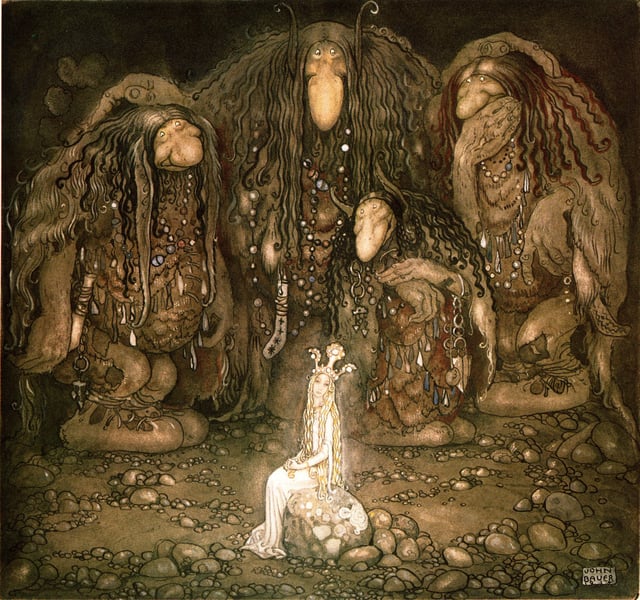
John Bauer's illustration of trolls and a princess from a collection of Swedish fairy tales
Vladimir Propp specifically studied a collection of Russian fairy tales, but his analysis has been found useful for the tales of other countries. Having criticized Aarne-Thompson type analysis for ignoring what motifs did in stories, and because the motifs used were not clearly distinct, he analyzed the tales for the function each character and action fulfilled and concluded that a tale was composed of thirty-one elements ('functions') and seven characters or 'spheres of action' ('the princess and her father' are a single sphere). While the elements were not all required for all tales, when they appeared they did so in an invariant order – except that each individual element might be negated twice, so that it would appear three times, as when, in Brother and Sister , the brother resists drinking from enchanted streams twice, so that it is the third that enchants him. Propp's 31 functions also fall within six 'stages' (preparation, complication, transference, struggle, return, recognition), and a stage can also be repeated, which can affect the perceived order of elements.
One such element is the donor who gives the hero magical assistance, often after testing him. In The Golden Bird , the talking fox tests the hero by warning him against entering an inn and, after he succeeds, helps him find the object of his quest; in The Boy Who Drew Cats , the priest advised the hero to stay in small places at night, which protects him from an evil spirit; in Cinderella , the fairy godmother gives Cinderella the dresses she needs to attend the ball, as their mothers' spirits do in Bawang Putih Bawang Merah and The Wonderful Birch ; in The Fox Sister , a Buddhist monk gives the brothers magical bottles to protect against the fox spirit. The roles can be more complicated. In The Red Ettin , the role is split into the mother—who offers the hero the whole of a journey cake with her curse or half with her blessing—and when he takes the half, a fairy who gives him advice; in Mr Simigdáli , the sun, the moon, and the stars all give the heroine a magical gift. Characters who are not always the donor can act like the donor. In Kallo and the Goblins , the villain goblins also give the heroine gifts, because they are tricked; in Schippeitaro , the evil cats betray their secret to the hero, giving him the means to defeat them. Other fairy tales, such as The Story of the Youth Who Went Forth to Learn What Fear Was
Analogies have been drawn between this and the analysis of myths into the Hero's journey.
Interpretations
Many fairy tales have been interpreted for their (purported) significance.
One mythological interpretation saw many fairy tales, including Hansel and Gretel , Sleeping Beauty , and The Frog King , as solar myths; this mode of interpretation subsequently became rather less popular. Freudian, Jungian, and other psychological analyses have also explicated many tales, but no mode of interpretation has established itself definitively.
Specific analyses have often been criticized for lending great importance to motifs that are not, in fact, integral to the tale; this has often stemmed from treating one instance of a fairy tale as the definitive text, where the tale has been told and retold in many variations.
In variants of Bluebeard , the wife's curiosity is betrayed by a blood-stained key, by an egg's breaking, or by the singing of a rose she wore, without affecting the tale, but interpretations of specific variants have claimed that the precise object is integral to the tale.
Other folklorists have interpreted tales as historical documents.
Many German folklorists, believing the tales to have preserved details from ancient times, have used the Grimms' tales to explain ancient customs.
One approach sees the topography of European Märchen as echoing the period immediately following the last Ice Age. Other folklorists have explained the figure of the wicked stepmother in a historical/sociological context: many women did die in childbirth, their husbands remarried, and the new stepmothers competed with the children of the first marriage for resources.
In a 2012 lecture, Jack Zipes reads fairy tales as examples of what he calls "childism". He suggests that there are terrible aspects to the tales, which (among other things) have conditioned children to accept mistreatment and even abuse.
Fairy tales in music
Fairy tales have inspired music, namely opera, such as the French Opéra féerie and the German Märchenoper. French examples include Gretry's Zémire et Azor , and Auber's Le cheval de bronze , German operas are Mozart's Die Zauberflöte , Humperdinck's Hänsel und Gretel , Siegfried Wagner's An allem ist Hütchen schuld! , which is based on many fairy tales, and Carl Orff's Die Kluge . Even contemporary fairy tales have been written for the purpose of inspiration in the music world. "Raven Girl" by Audrey Niffenegger was written to inspire a new dance for the Royal Ballet in London.
Compilations
Authors and works:
Mixed Up Fairy Tales
Alan Garner's Book of British Fairy Tales (United Kingdom, 1984) by Alan Garner
Fairy Tales (United States, 1965) by E. E. Cummings
Fairy Tales, Now First Collected: To Which are Prefixed Two Dissertations: 1. On Pygmies. 2. On Fairies (England, 1831) by Joseph Ritson
Giovanni Francesco Straparola (Italy, 16th century)
Grimms' Fairy Tales (Germany, 1812–1857)
Hans Christian Andersen (Denmark, 1805–1875)
Italian Folktales (Italy, 1956) by Italo Calvino
Joseph Jacobs (1854–1916)
Legende sau basmele românilor (Romania, 1874) by Petre Ispirescu
Madame d'Aulnoy (France, 1650–1705)
Norwegian Folktales (Norway, 1845–1870) by Peter Christen Asbjørnsen and Jørgen Moe
Narodnye russkie skazki (Russia, 1855–1863) by Alexander Afanasyev
Pentamerone (Italy, 1634–1636) by Giambattista Basile
Charles Perrault (France, 1628–1703)
Panchatantra (India, 3rd century BCE)
Popular Tales of the West Highlands (Scotland, 1862) by John Francis Campbell
Ruth Manning-Sanders (Wales, 1886–1988)
Franz Xaver von Schönwerth (Germany, 1810-1886)
Kunio Yanagita (Japan, 1875–1962)
Update on Rumpelstiltskin and other Fairy Tales by 43 Authors (Germany, 1976) by Hans-Joachim Gelberg and Willi Glasauer
World Tales (United Kingdom, 1979) by Idries Shah
Kaloghlan (Turkey, 1923) by Ziya Gökalp
"The Annotated Classic Fairy Tales" (United States, 2002) by Maria Tatar
See also
Aarne–Thompson classification systems
List of fairy tales
List of Disney animated films based on fairy tales
Nursery rhyme
